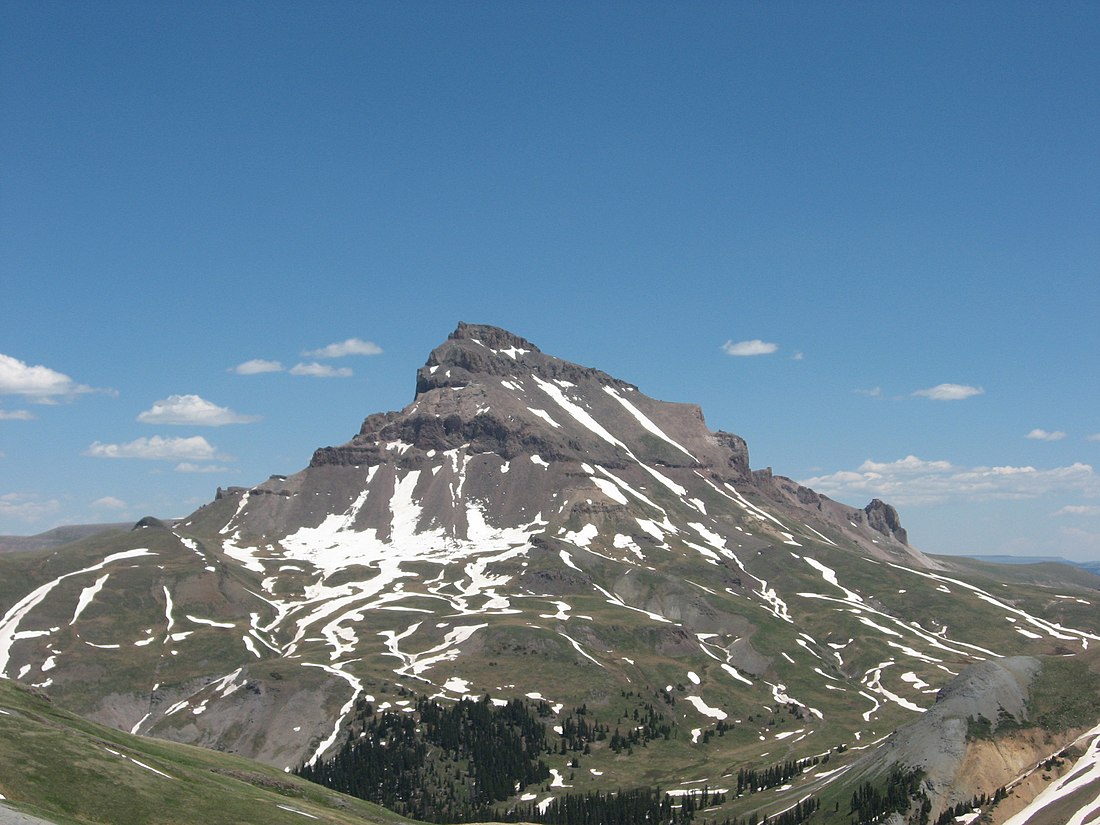Top Qs
Timeline
Chat
Perspective
San Juan Mountains
Mountain range in Colorado and New Mexico, United States From Wikipedia, the free encyclopedia
Remove ads
The San Juan Mountains is a high and rugged mountain range in the Rocky Mountains in southwestern Colorado and northwestern New Mexico. The area is highly mineralized (the Colorado Mineral Belt) and figured in the gold and silver mining industry of early Colorado. Major towns, all old mining camps, include Creede, Lake City, Silverton, Ouray, and Telluride. Large scale mining has ended in the region, although independent prospectors still work claims throughout the range. The last large-scale mines were the Sunnyside Mine near Silverton, which operated until late in the 20th century, and the Idarado Mine on Red Mountain Pass, which closed in the 1970s. Famous old San Juan mines include the Camp Bird and Smuggler Union mines, both located between Telluride and Ouray.
Remove ads

The Summitville mine was the scene of a major environmental disaster in the 1990s when the liner of a cyanide-laced tailing pond began leaking heavily. Summitville is in the Summitville caldera, one of many extinct volcanoes making up the San Juan volcanic field. One, La Garita Caldera, is 35 miles (56 km) in diameter. Large beds of lava, some extending under the floor of the San Luis Valley, are characteristic of the eastern slope of the San Juans. The eruption of the La Garita Caldera shaped the San Juan Mountains by completely obliterating the volcanoes that once stood in the area. [1]
Tourism is a major part of the regional economy, with the narrow gauge railway between Durango and Silverton being an attraction mostly in the summer and fall. Off-roading is popular on the old trails which linked the historic mining camps, including the notorious Black Bear Road. Visiting old ghost towns is popular, as is wilderness trekking and mountain climbing. Many of the old mining camps are popular sites of summer homes. Though the San Juans are extremely steep and receive much snow, so far only Telluride has made the transition to a major ski resort. Purgatory Resort, once known as Durango Mountain Resort, is a small ski area 26 miles north of Durango.[2] There is also skiing on Wolf Creek Pass at the Wolf Creek ski area. Recently Silverton Mountain ski area has begun operation near Silverton. The range is also a popular destination for endurance sports like trail running and mountain biking; Silverton is home to the Hardrock 100 Endurance Run one of the most difficult and technical ultra-marathons in the world.[3]
The Rio Grande drains the east side of the range. The other side of the San Juans, the western slope of the continental divide, is drained by tributaries of the San Juan, Dolores and Gunnison rivers, which all flow into the Colorado River.
The San Juan and Uncompahgre National Forests cover a large portion of the San Juan Mountains. The Continental Divide Trail, a long-distance hiking trail follows the crest of the San Juan Mountains. The Weminuche Wilderness, Colorado's largest wilderness area, with an area of 499,771 acres (202,250 ha) is in the San Juans. 152 miles of the Continental Divide trail are located on Trail #813 which follow through the San Juan wilderness and Weminuche Wilderness. [4]
The San Juan Mountains are also distinctive for their high altitude plateaus and peaks. As a result, facilities in the towns and cities of the region are among the highest in the nation. Telluride Airport, at an elevation of 9,070 feet,[5] is the highest in the United States with regularly scheduled commercial service.
Remove ads
Prominent peaks








- Note: This is only a partial list of important peaks in the San Juans, listing peaks by prominence only. There are dozens more summits over 12,000 feet.

Remove ads
History of the area
Human history at the eastern edge of the San Juan Mountains dates back thousands of years. Smithsonian archaeologists have identified paleo-Indian sites that are about 5,000 years old, located near Great Sand Dunes National Park and at the northern edge of the San Luis Valley, close to Poncha Pass. This suggests that early human presence in the region dates back to ancient times, long before the establishment of modern landmarks.[7]
Mining operators in the San Juan mountain area formed the San Juan District Mining Association (SJDMA) in 1903, as a direct result of a Western Federation of Miners proposal to the Telluride Mining Association for the eight-hour day, which had been approved in a referendum by 72 percent of Colorado voters.[8] The new association consolidated the power of thirty-six mining properties in San Miguel, Ouray, and San Juan counties.[9] The SJDMA refused to consider any reduction in hours or increase in wages, helping to provoke a bitter strike.
360° panorama of the northwestern San Juans, photographed from the Gold Hill Ridge of the Telluride Ski Resort. Ridgeline annotation indicates the names and elevations of 43 visible peaks
Remove ads
See also
References
Further reading
External links
Wikiwand - on
Seamless Wikipedia browsing. On steroids.
Remove ads



